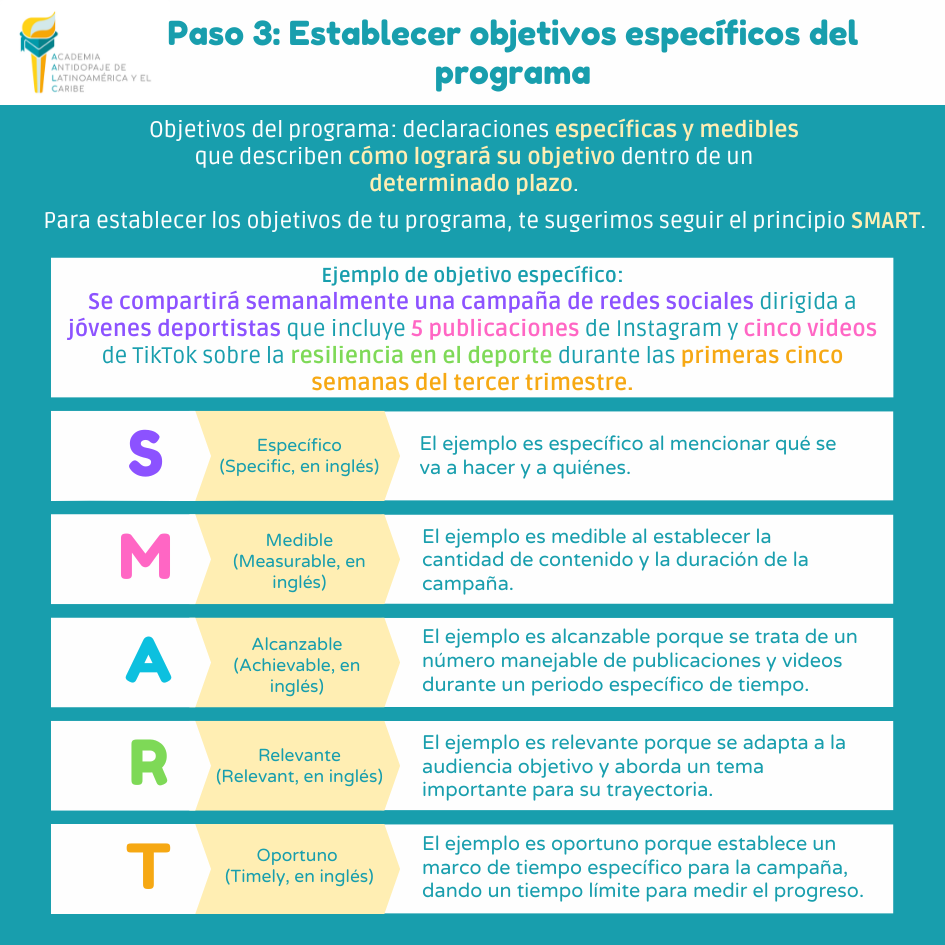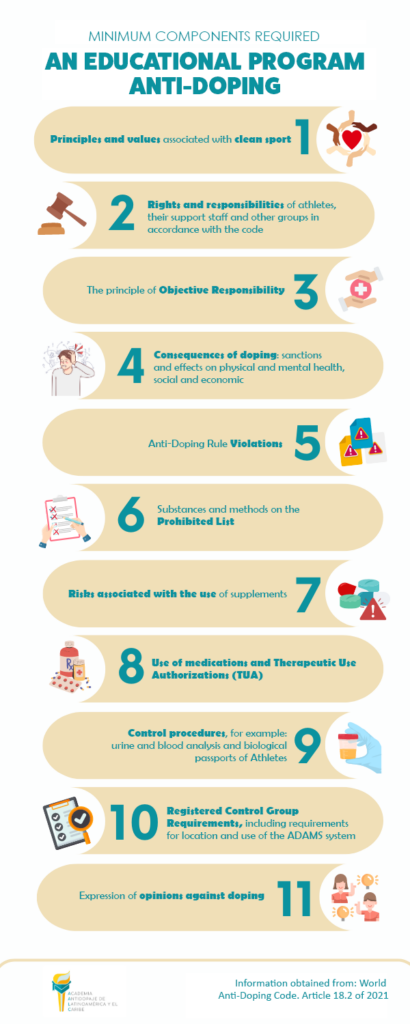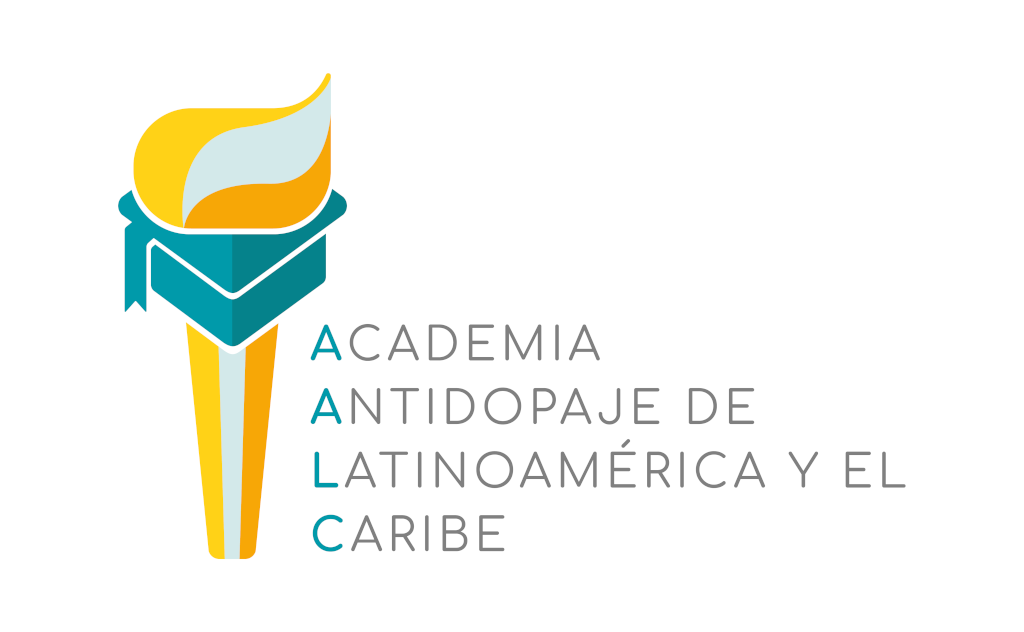- 4 Sections
- 24 Lessons
- 5 Days
- Module 1. Essential foundations for building an Anti-Doping Program¿Te has preguntado alguna vez por qué la educación en antidopaje es fundamental en el mundo del deporte? Te damos la bienvenida a esta lección, donde conocerás 4 temas de gran relevancia para la creación de un programa educativo antidopaje ¡Sigamos adelante!8
- 1.1Lesson 1. The importance of an anti-doping educational program
- 1.2Lesson 2. Education as a key to the anti-doping program
- 1.3Lesson 3. The athlete’s career
- 1.4Lesson 4. The Four Components of an Educational Program | First Themes
- 1.5Lesson 4. The Four Components of an Educational Program | Second Themes
- 1.6Lesson 4. The Four Components of an Educational Program | Third Themes
- 1.7Evaluation | Module 1
- 1.8Module 1 Evaluation15 Minutes6 Questions
- Module 2. Designing for clean sport: Planning an educational programBefore beginning to create an educational program, it is necessary to conduct a self-assessment to determine the best way to create an educational program, always considering specific needs.14
- 2.1Designing for clean sport: Planning an educational program
- 2.2Lesson 1. Diagnosis: evaluation of the current situation
- 2.3Task 1. Making a Diagnosis30 Minutes
- 2.4Lesson 2. Establishment of common education group
- 2.5Task 2. Establishing my Education Groups.30 Minutes
- 2.6Lesson 3. Design and development of the Educational Plan | Evaluation and Global Goals
- 2.7Tarsk 3. Assessing Needs and Creating my Overall Goal.60 Minutes
- 2.8Lesson 3. Design and Development of the Educational Plan | Themes and Objectives
- 2.9Task 4. Defining Program Objectives and Themes.2 Hours
- 2.10Lesson 3. Design and Development of the Educational Plan | Learning Objectives and Planning
- 2.11Task 5. Learning Objectives and Educational Activities.2 Hours
- 2.12Lesson 3. Design and Development of the Educational Plan | Consignment and Procedures
- 2.13Task 6: Establishing Monitoring and Evaluation Procedures3 Hours
- 2.14Lesson 3. Design and Development of the Educational Plan | Share with interested parties
- Module 3. The Implementation of the anti-doping educational programIn this module, we will talk about the elements to take into account when designing the learning experience, about how people learn and what helps or hinders the learning process.7
- 3.0The Implementation of the Anti-Doping Educational Program.
- 3.1Lesson 1. Design of the Learning Experience.
- 3.2Lesson 2. Value-based education
- 3.3Lesson 3. How to implement the 4 components in the athlete’s career.
- 3.4Lesson 4. Session Plan Creation
- 3.5Evaluation Module 3 | Knowledge Quiz10 Questions
- 3.6Evaluation Module 3 | Knowledge Quiz
- Module 4: Supervision and evaluation of the anti-doping educational programIn this module, we'll talk about the data you can collect to measure whether your program is meeting its objective or whether any part of it needs to be restructured.4
Lesson 3. Design and Development of the Educational Plan | Themes and Objectives
Step 3: Establish specific programmatic objectives
Now that we have our general objective, whether it is the one that applies to all groups or a specific one for each group following the athlete’s career, it is time to write the specific programmatic objectives.
Note: Program objectives are different from learning objectives.
Review the following infographic to identify how to write these objectives:

Now that you have reviewed the SMART features that will help you create good goals, we invite you to take the following test. Read the objective that will be presented on the screen and choose the characteristic or characteristics that you need (Specific, Measurable, Attainable, Relevant and Timely).
Good job! Now you know the considerations you must take when establishing the education group for your Anti-Doping Educational Program.
Remember: It is important that your objectives are specific and measurable, as this will allow you to plan the rest of your educational program, monitoring and evaluating your progress.
Step 4: Define topics for each target group
Now that you have described the objectives, you are clear WHAT it is you want to achieve.
Step 4 is determining HOW you will achieve it.
Do you remember that when evaluating the needs you identified the knowledge that the different target groups already have? It is time to determine what topics are important for them to learn so that they can cover that knowledge and develop those skills that they lack.
To establish topics, consider the mandatory topics required by all anti-doping educational programs and other recommended content.
Required topics
As you will remember, in the first module we reviewed that there are certain components and information that are mandatory in accordance with Article 18.2 of the World Anti-Doping Code, therefore, we leave you the infographic again so that you remember those topics.

Other content
In addition to the mandatory topics, your organization may have other content requirements, for example: specific values, practices or unique policies that need to be contained in the program. To learn more about this other type of content, we invite you to review the following interactive:
Very good! Now that you have reviewed Step 3 and Step 4, it is time to continue enriching your Anti-Doping Educational Program.
